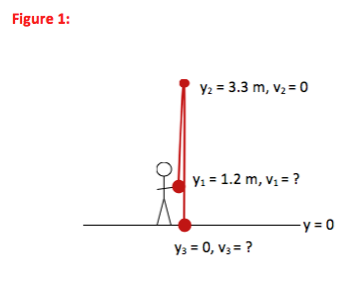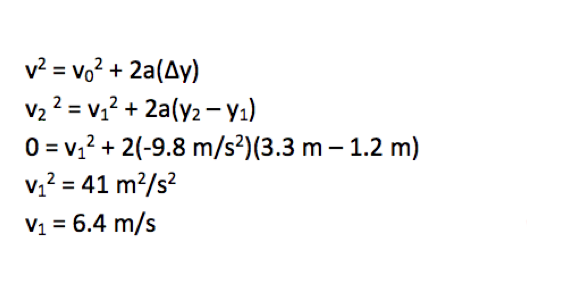The 2 Kg Ball Is Thrown So That It Travels Horizontally at 10 M S
You want to throw a ball straight upwardly into the air so that it reaches a pinnacle of 3.3 yard above the footing.
a) If the ball leaves your hand at a height of i.2 m above the footing, how fast do you need to throw it?
b) How long does it take the brawl to striking the basis? You lot may ignore any effects of air resistance throughout this problem.
-
In this problem, y'all are asked to describe the movement (how fast, how far, how long) of the brawl. Whenever you lot are asked to describe the motion of an object without worrying about the cause of that motion, you accept a kinematics problem.
-

- View Queries
-

There are three central kinematic equations. If you carefully select the equation which nearly directly describes the state of affairs in your trouble, you will not only solve the problem in fewer steps just as well understand it better. The iii equations, written for motion in the y-direction, are:
ane. y = y0 + 50Δt + ½ a(Δt)ii (relates position and time)
2. five = v0 + aΔt (relates velocity and fourth dimension)
3. v2 = v0 2 + 2a(Δy) (relates velocity and position)a) The initial velocity of the ball is a variable in all three equations, so this question drives home the bespeak that there is more to selecting the appropriate relationship than simply noting what value is requested in the trouble. In this case, you lot want to find the starting velocity that gives a maximum height of 3.3 m. Maximum height is the position at which y-velocity is zero. The question relates position and velocity, so you desire to apply equation 3.
b) Yous are asked how long ( time ) it takes the ball to reach the ground ( position ), so y'all desire to utilise equation ane.
- View Queries
-
Step ane:


The velocity when the ball left your hand (Bespeak 1) is the information that was requested in part a) of the trouble.
- View Queries
--------------------------------------------------------------------------------------------
Step 2:
Function b) of the problem asked for the amount of time the ball was in the air (between Signal 1 and Point 3.) No farther mathematical solution is required.
- View Queries
-

five2 two = vane ii + 2a(yii – y1)
0 = 512 + 2(-9.8 k/stwo)(three.3 m – 1.2 m)
vi = half-dozen.iv g/due southIn this problem, you were beginning asked to find how fast you needed to throw the brawl. In other words, you were asked to observe the initial velocity of the ball. Because all equations include initial velocity, you could not use that every bit a benchmark to select the best formula. Nevertheless, you know that the ball reaches a maximum height (vy = 0 at the elevation of the motility) of 3.three thou, so the all-time relation to select is the ane that relates position and velocity. The speed of six.4 m/s is virtually 14 mph, and so is a reasonable reply.
y3 = y1 + 51Δt + ½ a(Δt)ii
0 = 1.2 m + (6.4 g/s) Δt + ½ (-9.8 k/southii)( Δt)2
Δt = -0.16 s or +1.v s
Δt = 1.5 southIn part b), y'all were asked to discover how long (fourth dimension) it took the brawl to accomplish the ground (position) and so the position-time equation was used between the initial and last locations. Considering the position-fourth dimension equation includes a ( Δt)2 term, it will ever requite two answers for fourth dimension. The solution that makes physical sense is the positive time, or i.five s afterwards the brawl leaves your mitt.
0 Response to "The 2 Kg Ball Is Thrown So That It Travels Horizontally at 10 M S"
Post a Comment